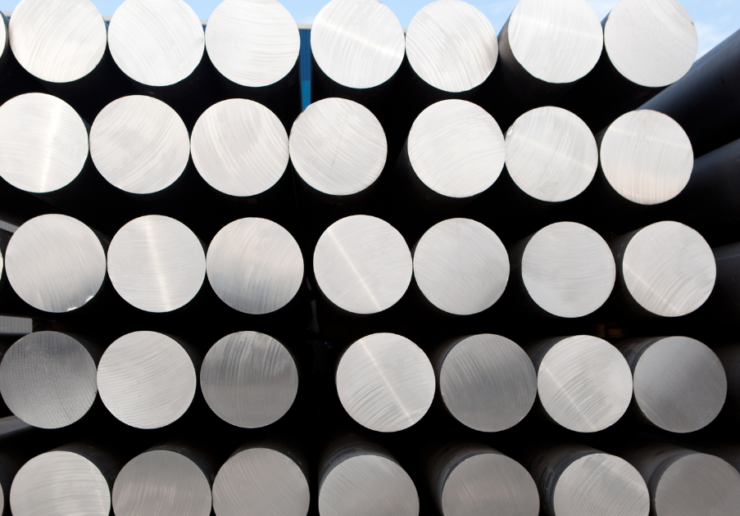Kloeckner Metals sells 6061 aluminum, one of the most versatile aluminum alloys. Contact us today for a quote.

6061 aluminum is one of the most common aluminum alloys that is often specified for its combination of strength, ease of heat treatment, and comparatively easy machining and weldability.
In addition to its favorable characteristics, aluminum 6061 bar can also be anodized, giving the bar an extra layer of protection.
6061 aluminum bar is very common type of aluminum that is used in the construction and automotive industries.
You will find 6061 aluminum in motorcycles, bicycle frames, yachts, camera lenses, scuba tanks, electrical fittings, fishing reels, couplings, valves, and more.
Machinability of the T6 tempers is good. However, it is less easy to machine when annealed.
6061 aluminum bar can be welded by all conventional methods. For thinner sections, gas tungsten arc welding is the most common approach. For heavier sections, gas metal arc welding is recommended. Alloy 4043 can be used for welding, but you can expect a decrease in T6’s mechanical properties.
Heat treatment takes place at 990°F. Allow enough time for the piece to be thoroughly and evenly heated, then quench in water. Precipitation hardening can take place at 320°F for 18 hours, followed by air cooling, followed again by 350°F and, again, air cooling.
In addition to its favorable characteristics, aluminum 6061 bar can also be anodized, giving the bar an extra layer of protection.
6061 aluminum bar is very common type of aluminum that is used in the construction and automotive industries.
You will find 6061 aluminum in motorcycles, bicycle frames, yachts, camera lenses, scuba tanks, electrical fittings, fishing reels, couplings, valves, and more.
Machinability of the T6 tempers is good. However, it is less easy to machine when annealed.
6061 aluminum bar can be welded by all conventional methods. For thinner sections, gas tungsten arc welding is the most common approach. For heavier sections, gas metal arc welding is recommended. Alloy 4043 can be used for welding, but you can expect a decrease in T6’s mechanical properties.
Heat treatment takes place at 990°F. Allow enough time for the piece to be thoroughly and evenly heated, then quench in water. Precipitation hardening can take place at 320°F for 18 hours, followed by air cooling, followed again by 350°F and, again, air cooling.
ANSWER:
Aluminum 6061 has a density of 2.7 g/cc (metric) or 0.0975 lb/in³ (imperial).
ANSWER:
The thermal conductivity, or diffusivity, of both aluminum 6061 tempers is 68 mm²/s (imperial) or 170 W/m-K.
ANSWER:
The tensile strength of aluminum 6061 depends on its temper.
ANSWER:
T6 and T6511 are both tempers, or variants, of 6061 aluminum. They have the same alloy composition, but have different mechanical properties are a result of their different processing. Some notable differences:
ANSWER:
Aluminum 6061 has a density of 2.7 g/cc (metric) or 0.0975 lb/in³ (imperial).
ANSWER:
The thermal conductivity, or diffusivity, of both aluminum 6061 tempers is 68 mm²/s (imperial) or 170 W/m-K.
ANSWER:
The tensile strength of aluminum 6061 depends on its temper.
ANSWER:
T6 and T6511 are both tempers, or variants, of 6061 aluminum. They have the same alloy composition, but have different mechanical properties are a result of their different processing. Some notable differences:
Steel base plates are fundamental elements employed in various manufacturing processes. These flat, rectangular...
Metal fabrication is a critical process that transforms raw metal materials into finished products....
The solar industry has undergone a significant transformation by incorporating steel products into various...
The unprecedented pace of solar growth is challenging and reforming America’s construction and engineering...
If you’ve got a roof over your head, it’s partly thanks to purlins. A...
Acquiring highly profitable company with annual sales of around USD 30 million Significant expansion...
A stainless steel depot is a specialized facility or supplier that stocks and provides...
American manufacturers use about 28.2 billion pounds of aluminum every year, 41.6% of it...
Leading steel distributor expands commitment to sustainability in the North American market. Kloeckner Metals,...
At Kloeckner, we are excited to announce that our Santa Fe Springs, CA location...

X
The Kloeckner Metals website uses modern technologies. Unfortunately, your browser doesn't support those technologies.
Download the latest version of one of these browsers to experience the site: